by T. Sabaratnam, September 19, 2004
Chapter 15
Original index to series
Original Chapter 16
Endless Talking
Curiously, Indira Gandhi’s Track One fitted perfectly into Jayewardene’s Track Two. Indira Gandhi utilized her Second Track of arming Tamil militants to achieve the objectives of her First Track: to obtain for the Tamils a self-governing unit within a united Sri Lanka and to force Jayewardene to return to the path of non-alignment. Jayewardene made use of Indira Gandhi’s Track One – talks – to buy time to achieve the aims of his First and Third Tracks: a military solution and destruction of the base of Tamil Eelam.
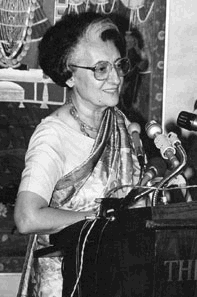
Indira Gandhi 1982
In her third telephone call of 17 August 1983, Indira Gandhi told Jayewardene her decision to send Gopalaswamy Parthasarathy as her special envoy to negotiate a political settlement to the Tamil problem. Jayewardene readily agreed. Talks suited him. It gave him the time he needed to build his military machine.
In the first round of talks with Parthasarathy during 25-29 August Jayewardene obstinately struck to the District Development Council (DDC) scheme knowing that the Tamil groups had rejected it. By doing so, he prepared the ground to drag on the talks. Parthasarathy told him firmly that DDCs would not satisfy the aspirations of the Tamil people. (Refer to Chapter 10).
Jayewardene launched a campaign to discredit Parthasarathy’s role as a peace broker. Lake House in which I worked was used as the anchor for that propaganda onslaught. The attempt was to show the world that Parthasarathy was not an honest broker.
Through this campaign, Jayewardene gained two months. But during these two months, Tamils also gained strength. The daring Batticaloa jailbreak of 23 September and Amirthalingam’s successful tour of the US, UK and Europe were their gains. Jayewardene tried to offset the gains from Amirthalingam’s tour through a bitter campaign against him to show the world that he was in fact backing terrorism.
The chance arrest of a 19-year old university student, Valluvan Rajalingam, gave Jayewardene the necessary stuff for his propaganda. Valluvan was arrested by the army on 7 October 1983 at Thalaimannar. He was returning from Chennai to where he had taken his sister Malarvalli who was betrothed to Amirthalingam’s second son, Bahirathan. Valluvan brought with him three letters Bahirathan had given him. They were written in Tamil. For the military, at that time, carrying anything written in Tamil was sufficient reason for arrest.
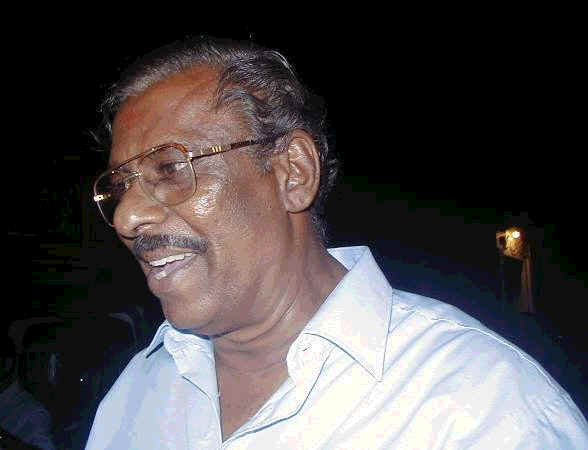
Mavai Senathirajah, MP, 2004 (photo courtesy TamilNet)
The letter written by Bahirathan to Mavai Senathirajah, secretary, TULF youth wing, interested police investigators. It referred to an armed group Bahirathan had set up. It spoke of talks Amirthalingam was having with Libya to obtain assistance for the armed group. It also spoke about a meeting Amirthalingam had had with Pirapaharan. The government made use of these facts to discredit Amirthalingam. Valluvan was interviewed on television and made to read the letter. The thrust of the government propaganda was to show Amirthalingam as a man behind Tamil terrorism. He spoke of Gandhism and nonviolence while encouraging and backing terrorism, the propagandists tried to show.
The government propaganda machinery also accused the armed group Bahirathan had set up for the murder of Pulendran, the UNP organizer for Vavuniya. Pulendran was shot and killed in August while watching television. The sentence in Bahirathan’s letter which read, “We claim responsibility for killing Pulendran,” was made use of for this purpose.
Pulendran was killed by the EPRLF. The government knew it. But the police wanted to put the blame on the armed group Bahirathan started. That served the government’s propaganda purpose.
Amirthalingam was in London when Valluvan was arrested and the propaganda onslaught on him was unleashed. He denied the accusations. He called the letter a fabrication. “The TULF had no links with the Tigers or any other militant organization,” he told the BBC.
The TULF went to Amirthalingam’s defence. Its politbureau met in Chennai on 17 October and released a statement rejecting the government allegations. The statement said, “We wish to point out that our political party is committed to the policy of nonviolence. We totally reject any effort to directly or indirectly implicate the party in any incidents of violence or with any violent movement or organization.”
The government organized a special press conference the next day at the Information Department to counter Amirthalingam’s denial and the TULF’s statement. It released the other two letters. The letter Bahirathan wrote to R. Jayarajah, private secretary to Mannar Member of Parliament, Soosaithasan said the extent of the land bought to establish the training camp was 13 acres. The other letter Bahirathan wrote to Premkumar said recruits from Mannar and Vavuniya were being trained in ‘air rifle.’
The facts that Amirthalingam met Pirapaharan and Bahirathan started an armed group were true. Amirthalingam was upset when he came to know about India’s arms training to Tamil militant groups. He was already having problems with the armed groups. His decision in 1982 to accept and work for the District Development Council scheme was vehemently criticized by the militant groups. His decision to contest the DCC election placed the TULF and the armed groups in direct conflict. Militant groups claimed that the TULF had lost the mandate it obtained from the people in the 1977 election to set up a separate state and the leadership of the Tamil people had passed to them.
The challenge to the TULF’s leadership intensified after Amirthalingam’s announcement in Delhi after his meeting with Indira Gandhi on 5 September that he was prepared to negotiate with the Sri Lankan government with Indian mediation. The TULF, he said, had decided to vary the Mannar Convention decision not to talk to Colombo. “The situation has changed since then. The mission of Mr. G. Parthasarathy has positively created a new movement towards finding a solution to the Tamil problem,” he said.
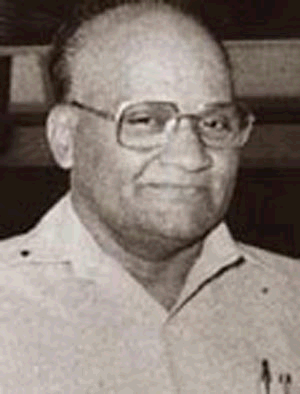
A. Amirthalingam
Militant groups unleashed a stern campaign against Amirthalingam. They called him a traitor to the Tamil cause. They asked him not to talk to Jayewardene whom they charged with deception. The LTTE, in a statement issued from Chennai, said Jayewardene was only trying to buy time to build the military machine to crush the Tamil freedom struggle. The statement asked Amirthalingam not to be a collaborator.
Amirthalingam met Pirapaharan to explain his position. He told him that Indira Gandhi was working in accordance to a plan. She wanted Amirthalingam to talk with Jayewardene as part of that plan. He had given her an undertaking to act according to her directives. He pleaded with Pirapaharan to understand his plight. Amirthalingam told me that Pirapaharan had told him that he understood his plight. Despite that meeting, others in the LTTE and other armed groups continued to criticize Amirthalingam. Jayewardene lambasted Amirthalingam for that very meeting.
It was also true that Bahirathan had established the armed group, the Tamil Eelam National Army (TENA). It was the direct result of Amirthalingam’s fear that Indian weapons training would strengthen the armed groups and consolidate their claim to leadership. It was also born out of the fear that Delhi would accord more importance to the armed groups.
Amirthalingam and Bahirathan, who stayed with him, realized that having an armed group under their control would be the only way for the TULF to retain its influence and relevance. Bahirathan thus formed the TENA. He bought 13 acres of land in the Madurai district with the money collected by the TULF London branch and set up a training camp. The TENA did not have a training program as they had no weapons. The boys who joined the TNA lost patience and left. That was the brief history of the TENA.
Other militant groups mocked them. They asked, “How can the leaders who kept on chanting, ‘Nonviolence is our breath, throw away the weapons’ organize an armed group?’ And the Jayewardene government used the letter to destroy Amirthalingam politically.
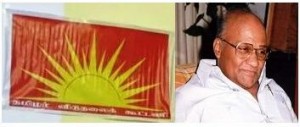
Amirthalingam with TULF flag
Two days later, 19 September, the propaganda barrage against Amirthalingam was suddenly halted. The reason, we were told, was the hard hitting statement Indira Gandhi made at a special press conference she held in Delhi in 18 September, soon after her meeting with Amirthalingam, Sivasithamparam and Sampanthan, the trio whom she called Three Musketeers.
She said a dangerous situation was developing in Sri Lanka. She gave three reasons for saying so. They were:
· Large-scale occupation of the Batticaloa district by Sinhala people.
· TULF MPs losing their seats in parliament,
· Colombo deliberately dragging its feet and delaying negotiations.
She announced she was sending Parthasarathy to Colombo to restart the talks.
Sinhala occupation, which formed part of Jayewardene’s Third Track of destroying the base of Tamil Eelam, will be dealt in depth in a subsequent chapter.
The TULF MPs lost their seats on 4 November, the day the 3-month period provided by the Sixth Amendment for MPs to take the oath of allegiance to the unitary constitution expired. The Opposition Leader post that Amirthalingam held also fell vacant. Thirty-four year old Anura Bandaranaike was elected the new Leader of the Opposition.
Jayewardene who had obtained full control of parliament with the four-fifth majority he obtained at the 1977 parliamentary election wanted a submissive and pliable leader of the opposition to make his power total. He had expected Amirthalingam to play such a role. He attacked Amirthalingam whenever he failed to do so.
As I have pointed out in my first volume, Jayawardene also destroyed his main political opponent, Sri Lanka Freedom Party (SLFP) leader Sirimavo Bandaranaike, by depriving her of her civic rights and by manipulating a split among her three children and among the 8-member parliamentary group. He manipulated a split between Sirimavo’s second child Chandrika, who married an ambitious film star turned politician named Vijeya Kumaratunga, and her third child, Anura, who being the only male heir to the Bandaranaike dynasty aspired to the leader of the SLFP.
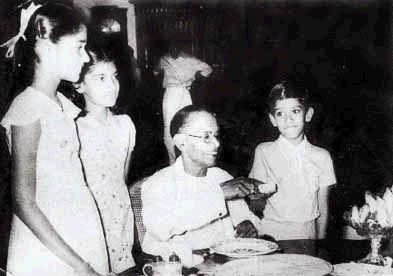
Chandrika, Sunetra, Solomon and Anura Bandaranaike
The split between Chandrika and Anura also resulted in a split in the SLFP and its parliamentary group. Anura defected in 1981 from the SLFP with a party senior, Maithripala Senanayake, and his group, called the SLFP (M), though it had only three members, was recognized by parliament, at the instance of Jayewardene, as the official SLFP representatives. This manipulation helped Anura to succeed Amirthalingam as the Leader of the Opposition.
Arrival of Parthasarathy
Jayewardene was not particularly worried about Indira Gandhi’s grim comment that he was dragging his feet and delaying negotiations. That was his strategy. He invited Parthasarathy to come to Colombo to commence the second round of talks.
Parthasarathy came to Colombo on 7 November and held a series of talks with Jayewardene, Gamini Dissanayake and Lalith Athulathmudali. His effort during this round of talks was to create regional councils with adequate powers that would enable the Tamils live within united Sri Lanka ruling themselves. He told Jayewardene and his ministers that the DDC scheme would not satisfy the aspirations of the Tamils, as their demand was for a separate state.
Parthasarathy’s achievement in the second round of talks which concluded on 10 November was to get Jayewardene to agree to the merger of two or more DDCs within a province. However, Jayewardene insisted and included a delaying mechanism in the proposal which said, “provided that the council members voted for such a merger and the people voted in favor of the merger in the respective council areas in a referendum.”
The Presidential Secretariat issued a statement on 10 November embodying these proposals. It said the President hoped that the implementation of these proposals would lead to the reduction of violent activities. It also said the President expected the Tamils to reciprocate by disavowing separation and by recognizing Trincomalee port as a central function.
Parthasarathy, who considered the acceptance of the concept of merger as an important development, issued a separate statement indicating his preference for regional councils. His statement said, “These talks essentially centered on the creation of regional councils with appropriate powers within the framework of a united Sri Lanka.”
Tamil militant groups saw through Jayewardene’s strategy. The LTTE issued a statement rejecting the Colombo proposals saying that that was merely a “time buying exercise.” The LTTE also warned the TULF not to get caught in Jayewardene’s trap and declared that the demand for a separate state was nonnegotiable.
JR meets Indira
Indira Gandhi invited Jayewardene ,who was scheduled to visit Delhi to attend the Conference of the Commonwealth Head of Governments, for talks with her.
Jayewardene flew to New Delhi on 21 November with his brother H W Jayewardene. Foreign Minister Hameed and Foreign Ministry officials went two days early. Thondaman also went to Delhi on the invitation of Parthasarathy.
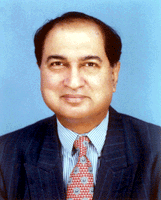
G. Parthasarathy
Indira Gandhi invited the TULF leaders to Delhi to brief her on the situation in Sri Lanka and on the stand and expectations of the Tamil people. Amirthalingam, Sivasithamparam and Sampanthan went from Chennai. Dr. Neelan Tiruchelvam flew from Colombo to join them. This invitation angered Jayewardene and annoyed Tamil militant groups. Jayewardene, in keeping with his habit, unleashed a vitriolic propaganda campaign against the TULF and India. The media charged India with according to Amirthalingam the importance given to a head of state, an oblique reference to the special guest status meted out to him at the Indian independence day celebration the previous 15 August. The media also accused Indira Gandhi of being partial towards the Tamils.
Parthasarathy had a series of discussions on 17 and 18 November with TULF leaders to ascertain their position. They told him that Tamils would not yield on two basic demands: merger of the north and east and a Tamil-speaking police force. Parthasarathy also met Thondaman.
Parthasarathy called on Jayewardene who was accommodated in the President’s Suite in the Ashok Hotel where the heads of states and governments stayed. He briefed Jayawardene about the TULF response to the Colombo proposals. He told Jayewardene the TULF welcomed his decision to permit two or more DDCs to merge. They wanted the merger concept widened to cover DDCs outside provincial boundaries. He told Jayewardene the TULF was agreeable to Trincomalee port being under the central government, but wanted the limits of the port area to be defined.
Then Parthasarathy told Jayewardene of the main areas of disagreement. The TULF opposed the holding of a referendum to decide the question of the merger of the DDCs. The TULF, he said, was insisting on the setting up of a separate Tamil police force. The TULF was prepared to permit the people of Ampara to decide their future.
Jayewardene’s response to the TULF stand was:
· On merger – He would do away with a referendum, but the merger should be within each province. He specifically indicated that he was opposed to the merger of the north and east.
· On a Tamil-speaking police force – He opposed it, but was willing to devolve a certain amount of law enforcement authority to the DDCs.
Parthasarathy conveyed Jayewardene’s reaction to Amirthalingam who got agitated. Amirthalingam told Parthasarathy: I cannot yield on merger and a separate police force. If I give in on those two matters I cannot even return to Chennai.” Sivasithamparam told me that Amirthalingam was so agitated that he wanted to break up the talks and return to Chennai. “It took a long time for the persuasive Parthasarathy to calm him down.”

Group photograph of Her Majesty Queen Elizabeth II of Britain with the Heads of the Governments of the Commonwealth countries during CHOGM in New Delhi on November 23, 1983
Realizing the fragile nature of the talks Parthasarathy varied his strategy. He arranged a meeting between Jayewardene and Indira Gandhi. The meeting took place late in the evening of 23 November, the day before the Commonwealth summit.
Indira Gandhi told Jayewardene that India supported the democratically elected government of Sri Lanka and was totally against the division of the country. She asked him to find a political solution to the Tamil problem within the country’s united framework. She apprised him of India’s concern – the influx of Tamil refugees and the strong feelings of the people of Tamil Nadu.
Jayewardene told her his problems: the Sinhala fear that Tamils would dominate the country; Sirimavo Bandaranaike’s opposition to yielding too much to the Tamil people and the risk he faced of his losing his political base.
The Commonwealth Summit opened on 24 November. Jayewardene, in his address, intentionally insulted Indira Gandhi. He recalled the meeting he had with Mahatma Gandhi and Jawaharlal Nehru and showered praises on them. He said that he was a follower of Mahatma’s non-violence and Nehru’s non-alignment.
He concluded his address thus, “If I have the strength to live, I will not let my people be subject to anybody. Fifteen million people will die if an atom bomb is exploded in Sri Lanka; fifteen million people can die if they are invaded by someone else and decide never to give in.” The reference was to a rumour that India planned to invade Sri Lanka.
Thondaman met Indira Gandhi the next day. He referred to Jayewardene’s speech and told her, “President Jayewardene praised your father very much. I hope you are pleased.”
Indira Gandhi exploded with anger. She said, “That old man was not praising my father. He was telling the world that I am not living up to my father.”
She alluded to Jayewardene’s speech when she met Tamil expatriates in New York in December. She told them that she would have ordered the invasion of Sri Lanka, but had reservations because of the defenselessness of the Indian plantation workers who live among the Sinhalese.
The Birth of Annexure C
After the formal opening of the conference, the participants went to Goa for a retreat. Parthasarathy also went to Goa to continue his discussions with Jayewardene. During the discussions, Parthasarathy covered in detail the unit of devolution and the powers to be devolved to those units.
Jayewardene refused to make any improvements on the unit of devolution, but agreed to enhance the powers of the units. However, he came up with another delaying mechanism: an All Party Conference (APC). He told Parthasarathy that he had to be able to carry all the parties and all shades of opinions with him if he were to implement the agreement. Parthasarathy agreed.
Sensing forward movement, Parthasarathy persuaded Jayewardene to extend his stay in Delhi. Parthasarathy also obtained his consent for a meeting with Indira Gandhi.
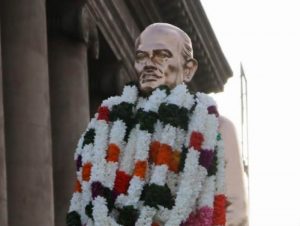
Ceylon Workers’ Congress Saumiyamoorthy Thondaman at the Presidential Secretariat, Galle Face, Colombo
The Commonwealth Summit concluded on 29 November. That night Parthasarathy decided to make a last try. He took with him Thondaman and Neelan Tiruchelvam and met Jayewardene in his suite. He presented a case for a larger unit of devolution. He told Jayawardene that a Provincial or Regional Council would serve the Tamils and the country better than DDCs. “It would result in an augmentation of power and resources. Tamils would need to be offered a package of proposals which seem a reasonable alternative to their basic demand,” he argued.
Neelan depicted the atmosphere in Jayewardene’s suite in his article G.P.’s decisive role published in Lanka Guardian of 1 September 1987 thus:
Mr. Jayewardene seemed tired and exhausted. He listened to the presentation without comment. He seemed listless, and it was not clear whether he had absorbed any of the points made. As the meeting ended and the delegation descended down Parthasarathy observed reassuringly. “I am 73. Mr. Thondaman is 70. But the old man is in his eighties. Age must take its inevitable toll.” Mr. Jayewardene, however, remained enigmatic. He had in fact followed the arguments advanced, and agreed next morning to the creation of Provincial Councils.
Parthasarathy, Thondaman and Neelan Tiruchelvam met Jayewardene on 30 November morning to get his response to the points they had raised the previous night. Jayewardene was fresh and vibrant, Neelan Tiruchelvam told me. Jayawardene told them that he had given deep thought to Parthasarathy’s arguments. “I may have difficulty back home. Anyhow, I have decided in favour of the creation of the Provincial Councils,” he said. Thondaman told me he was elated. “I thanked the President for taking that bold decision,” he said.
Parthasarathy took that opportunity to raise the matter concerning the participation of the TULF in the All Party Conference. He argued for the need to invite the TULF. Jayewardene told him of the cabinet decision not to talk with the TULF until it disavowed separatism. Parthasarathy told him that the TULF also had decided not to talk to the government. “It is the government and the TULF who have to talk,” Parthasarathy said. Jayewardene agreed to put the issue to the All Party Conference.
The three met Jayewardene again with the draft of the proposals on which they had agreed. Jayewardene read the draft carefully. At the end, Jayewardene asked Parthasarathy, “Where do I sign?” Parthasarathy replied, “This is not an agreement and no signatures are required,”
Jayewardene met Indira Gandhi on 30 November evening. They went over the proposals. She welcomed the advance made, but pressed for the creation of a single regional council for the northeast. Jayewardene demurred. He said Muslims and Sinhalese formed the majority in the Eastern province and he was worried about their future in a merged Northeast province. He added he could not erode the base of his support. He said he would agree only to the establishment of provincial councils, but he was prepared to compromise. He said the Tamil leadership, if it wanted, was free to advance the case of merger before the All Party Conference.
Indira Gandhi was satisfied with that assurance. “Let this be the first step for the final solution,” she said. Jayewardene gave Indira Gandhi a definite assurance to implement the proposals. She told Jayewardene that Amirthalingam would not be satisfied without merger. She told him that she would get Amirthalingam round. And she assured Jayewardene in clear terms that India is against secession and stands for the independence, integrity and sovereignty of Sri Lanka.
Indira Gandhi met the TULF leaders, Amirthalingam, Sivasithamparam, Sampanthan and Tiruchelvam along with Thondaman. She urged the TULF to accept the solution. Amirthalingam agreed to do so, but told her that he would not be able to face the Tamil people, as the proposals did not permit the merger of the north and east.
And he faced an uproar when he returned to Chennai. Militant groups rejected the proposals as it had failed to ensure the merger of the north and east. Amirthalingam was criticized for sacrificing the demands for Tamil Eelam and a Tamil homeland.
The TULF countered the criticism saying the proposals recognized the North and East as a single unit by accepting Tamil as the language of administration and courts in both the provinces.
Jayewardene returned to Colombo on 1 December 1983. He issued the following press statement:
On my visit to New Delhi to attend the meeting of the Commonwealth Heads of Government, I had the opportunity to discuss with Her Excellency Shrimati Indira Gandhi, the Prime Minister of India, the problem of Sri Lanka Tamils in Sri Lanka.
2. Before leaving for New Delhi, I had consultations on this matter with various political leaders in Sri Lanka. The Special Envoy of the Prime Minister of India, Mr. G. Parthasarathy, had also discussed this matter with me during his visits to Sri Lanka and in India.
3. It will be recalled, that I had made it clear that I could resume any discussions with the TULF to discuss the possible lines of a solution only if they give up their call for a separate state.
4. I am happy to say that according to available information the TULF is prepared to give up its call for a separate state, if a solution of the Tamil problem that is acceptable to them is worked out.
5. I am also happy to say that the Government of India has stated in clear terms that India is against secession and stands for the independence, integrity and sovereignty of Sri Lanka.
6. Mr. G. Parthasarathy, the Special Envoy of the Prime Minister of India, has had discussions with the members of the TULF who are in New Delhi and has obtained their response to the proposals that has emerged as a result of the discussions in Colombo in November. I will first consult all political parties in Sri Lanka on the modalities of summoning an all party conference to discuss these proposals. Once the modalities for this conference are settled, I will communicate to all parties the various proposals that have emerged, so that they will have an opportunity of studying them, before participating in this conference. Thereafter, I propose to summon a conference of the political parties at which these proposals will be discussed.
Jayewardene, thereafter, commenced the consultation process for the holding of the All Party Conference while stepping up his efforts to obtain weapons and training for the military. He had his plan to destroy the Tamil armed struggle carefully worked out.
Next: Chapter 17. All Party Conference
To be posted on September 24
###